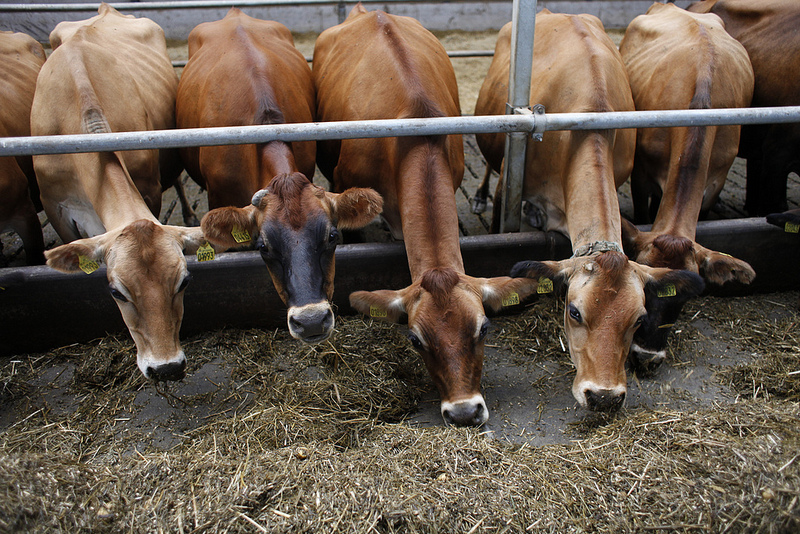Unless there is a "radical shift in meat and dairy consumption", it's unlikely we'll be able to keep global temperature rises to two degrees Celsius.
The world eats a lot of meat and we’re eating more and more each year. The supply of meat per person across the globe almost doubled in the 50 years between 1961 and 2011.
Growth in countries like China is even more pronounced – in 2011 the supply of meat to China was almost 16 times as much per person as in 1961. Even in countries such as the US and UK, supply has increased.
The problems with meat
The problem with meat production is that it’s so inefficient: livestock consume 4.6 billion tonnes of carbon per year in feed but the produce (meat and dairy) ends up as only 2.6% of that, even before losses are taken into account.1
What’s more, agriculture represents a significant proportion of global emissions, exceeding those from the transport sector. Experts estimate that the total global greenhouse gas emissions for livestock alone account for at least 14.5%,2 and possibly up to 51%.3
And one paper predicts that if current population and consumption trends continue, greenhouse gas emissions for livestock would increase by around 77%.4
With meat production being so inefficient, huge amounts of land are given over just to feeding animals – 75% of agricultural land and 23% of arable land worldwide5 – and increasing demand means that cattle farming also plays a major role in deforestation, both directly and indirectly.
In 2011, 90% of deforestation in Columbia was caused by cattle farming.6 75% of soy production, also a major contributor to deforestation, goes to feeding animals.7 Not only does deforestation destroy habitats and reduce biodiversity, it also destroys a valuable source of carbon storage and is a primary cause of carbon emissions in the agricultural sector.8
How will stopping eating meat help?
In principle, if everyone moved to a purely vegan diet we could feed 4 billion extra people.9 A reduction in the production of meat will also result in there being more land available for other uses – planting forests, bioenergy etc.
But perhaps most importantly, a 2014 report states that unless there is a “radical shift in meat and dairy consumption”, it’s unlikely we’ll be able to keep global temperature rises to two degrees Celsius.10
Not all land that is used for grazing would be suitable for growing crops – about 14% of feed by carbon mass comes from land like this – but its use for grazing “can still have negative consequences for carbon storage and biodiversity.”11
However, it is difficult to envisage a transition to entirely plant-based diets in all areas of the globe: many regions rely on livestock for food security as they can be fed on plants that aren’t suitable for human consumption or graze on land that couldn’t support crops.12
What’s your impact?
By transitioning from a high-meat to a vegetarian diet, your carbon emissions could decrease by about 3.38 kgCO2e per day (that’s 47% less). That’s roughly the equivalent of eating 3,084 loaves of bread per year.
If everyone in the UK aged 15-64 did the same thing, we could save about 38,605,845 tonnes of CO2e per year. That’s roughly the equivalent of taking 8,392,575 return flights from the UK to Hong Kong.
And don’t forget this just shows the estimated potential carbon savings, without taking into account the extra benefits that come with more land being available.
Explaining the diet calculations
- A high-meat diet in the UK equates to 7.19 kgCO2e per day, or 2,624.35 kgCO2e per year. A vegetarian diet in the UK equates to 3.81 kgCO2e per day, or 1,391 kgCO2e per year.13
- As a comparison, loaves of bread equates to about 0.40 kgCO2e, and 1 return flight from the UK to Hong Kong equates to about 4.60 tonnes CO2e.14
- There are an estimated 41,972,000 people (UK) in the 15-64 age bracket as of 2016.15
-
Bajželj, Bojana, Keith S. Richards, Julian M. Allwood, Pete Smith, John S. Dennis, Elizabeth Curmi, and Christopher A. Gilligan. 2014. Importance Of Food-Demand Management For Climate Mitigation pp. 925-926 ↩︎
-
Bailey, Rob, Antony Frogatt, and Laura Wellesley. 2014. Livestock – Climate Change’s Forgotten Sector ↩︎
-
Anhang, Jeff, Robert Goodland. 2009. Livestock and Climate Change: What if the key actors in climate change are…cows, pigs, and chickens? ↩︎
-
Bajželj et al. 2014. pp. 925-926 ↩︎
-
Bailey et al. 2014. ↩︎
-
Kissinger, Gabrielle, Martin Herold, Veronique De Sy. 2012. Drivers of Deforestation and Forest Degradation ↩︎
-
WWF. Soy is everywhere ↩︎
-
“The AFOLU sector is responsible for just under a quarter (~10–12 GtCO2eq/yr) of anthropogenic GHG emissions mainly from deforestation and agricultural emissions from livestock, soil and nutrient management.” IPCC. 2014. Climate Change 2014: Agriculture, Forestry and Other Land Use p816 ↩︎
-
Ravilios, Kate. 2014. Cutting meat consumption could feed 10 billion ↩︎
-
Bailey et al. 2014. ↩︎
-
Bajželj et al. 2014. ↩︎
-
“livestock can be fed on plants not suitable for human consumption or growing on land with high soil carbon stocks not suitable for cropping; hence, food production by grazing animals contributes to food security in many regions of the world.” IPCC. 2014. Climate Change 2014: Agriculture, Forestry and Other Land Use p838 ↩︎
-
Scarborough, Peter, Paul N. Appleby, Anja Mizdrak, Adam D. M. Briggs, Ruth C. Travis, Kathryn E. Bradbury, and Timothy J. Key. 2014. Dietary greenhouse gas emissions of meat-eaters, fish-eaters, vegetarians and vegans in the UK ↩︎
-
Berners-Lee, Mike. 2010. How Bad Are Bananas?: The Carbon Footprint of Everything ↩︎
-
World Bank. World DataBank ↩︎
